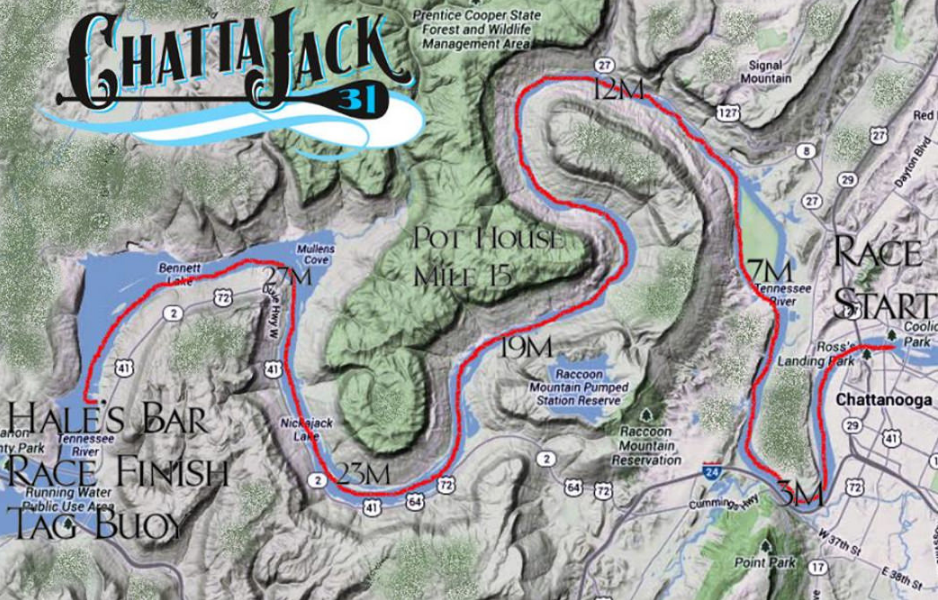An Endurance Paddling Event Unlike Any Other: ChattaJack31
The ChattaJack31 is arguably one of the most unique and impressive paddling events to enter the endurance racing stage in recent years. Traveling 31 miles from downtown Chattanooga through the incredibly scenic Tennessee River Gorge to Nickajack Lake, this event—now entering its fourth year—has quickly established itself as one of the country's premier flat water endurance races.
And this year, it is sure to be just as exciting, challenging, and rewarding as it has been in years past.
Race founder and SUP endurance specialist Ben Friberg conceived of ChattaJack as a way to share his love of the sport and of his hometown. And the impressive assemblage of national and international athletes that will make their way to the starting line on October 24 this year will offer a proud reminder of just how far this event has come in such a short time.
Racers—who paddle everything from standup or prone paddleboards, to surf skis, to kayaks, to outrigger or traditional canoes—understand that the organization of their gear is key. They must have their own water (4 liters, or two 70oz Camelbaks are recommended) as well as a US Coast Guard approved lifejacket, which doesn’t have to be worn but must be aboard the racing vessel.
Racers make their way from downtown, along I-24, past Lookout Creek and around the contour of historic Moccasin Bend, before passing Williams Island, which is the official beginning of the Tennessee River Gorge. There is a time check and cut off of 2 hours and 30 minutes at the Suck Creek boat ramp (mile 10). Racers who do not meet the cut off time will be assisted from the water by a race marshall and then shuttled back to the start or finish line, depending upon the volunteer’s/race’s demands.
As paddlers make their way into and through the Gorge—which starts just past Williams Island and continues 27 miles to the race’s end—they’ll have the support of two boat aid stations at miles 16 and 27, as well as a protruding doc aid station on the river 22 miles in. Each of these aid stations will have water and Hammer Nutrition bars and gels, but Friberg recommends racers carry nutrition in case they take longer than they expect between the aid stations or wish to pass by one without stopping. Additionally, participants may want to carry strobe lights, wind blocking and bright garments (the latter for increased visibility), warm booties (the water temperature can be as low as 68 degrees in October), a Global Positioning System (GPS) device, and a leash.
Randy Whorton, a first time ChattaJack racer in 2013, said the biggest challenge he faced as a novice paddleboarder and racer was that he crossed the river a few times in an effort to improve his line. Because he didn’t know the gorge well, however, the crossings ended up being a waste of time.
“Still, lesson learned,” he says. “The race made me a stronger and more confident paddler because I was out there, standing on my board and making my way through new challenges. It was a great day all around.”
Boat traffic can also pose a challenge for paddlers as they must navigate the wake generated by larger crafts. “The worst thing that will happen is you’ll fall in,” Whorton says. “The result will be that you’ll become more adept at managing the wake.”
The last section of the gorge as paddlers head into Nickajack Lake can be windy, but the finish line at Hales Bar Marina awaits, so what’s a little wind? With an overall cut-off time of 8.5 hours (or 4:30 p.m. Eastern time) and an award ceremony starting at 6:30 p.m. at Ross’s Landing Park back in Chattanooga, there’s plenty to keep paddlers headed toward the finish.
A few of the best things about ChattaJack31 are the fact that you’re on the water just as the sun is coming up in beautiful downtown Chattanooga. With the bridges, parks, a riverfront fountain, striking architecture, and lovely mountains surrounding the city, there are few prettier places you could be. (And for spectators, it's pretty amazing to see hundreds of paddlers take off through the sun-streaked, smooth waters of the Tennessee River.)
Most importantly for athletes, don't forget to take in your surroundings as you make your way downriver. Because you’re low on the water, you may see muskrats, beavers, river otters, fish, birds of prey, possibly deer, and a variety of river traffic. In early October, the gorge walls will tower above you on both sides, and a handful of their trees will be popping with fiery color against a crisp backdrop of blue sky (hopefully it’s blue!). Life from the river gives you a totally new perspective, so be sure to enjoy it while you’re out there—even if your toes are numb and your muscles aching. It's all part of the fun!
Originally written by RootsRated.









